Summaries by Nathan Elliott, J2 Interactive
Formatting and editing by Madeline Rizzo, J2 Interactive
| Part One | Part Two |
|---|
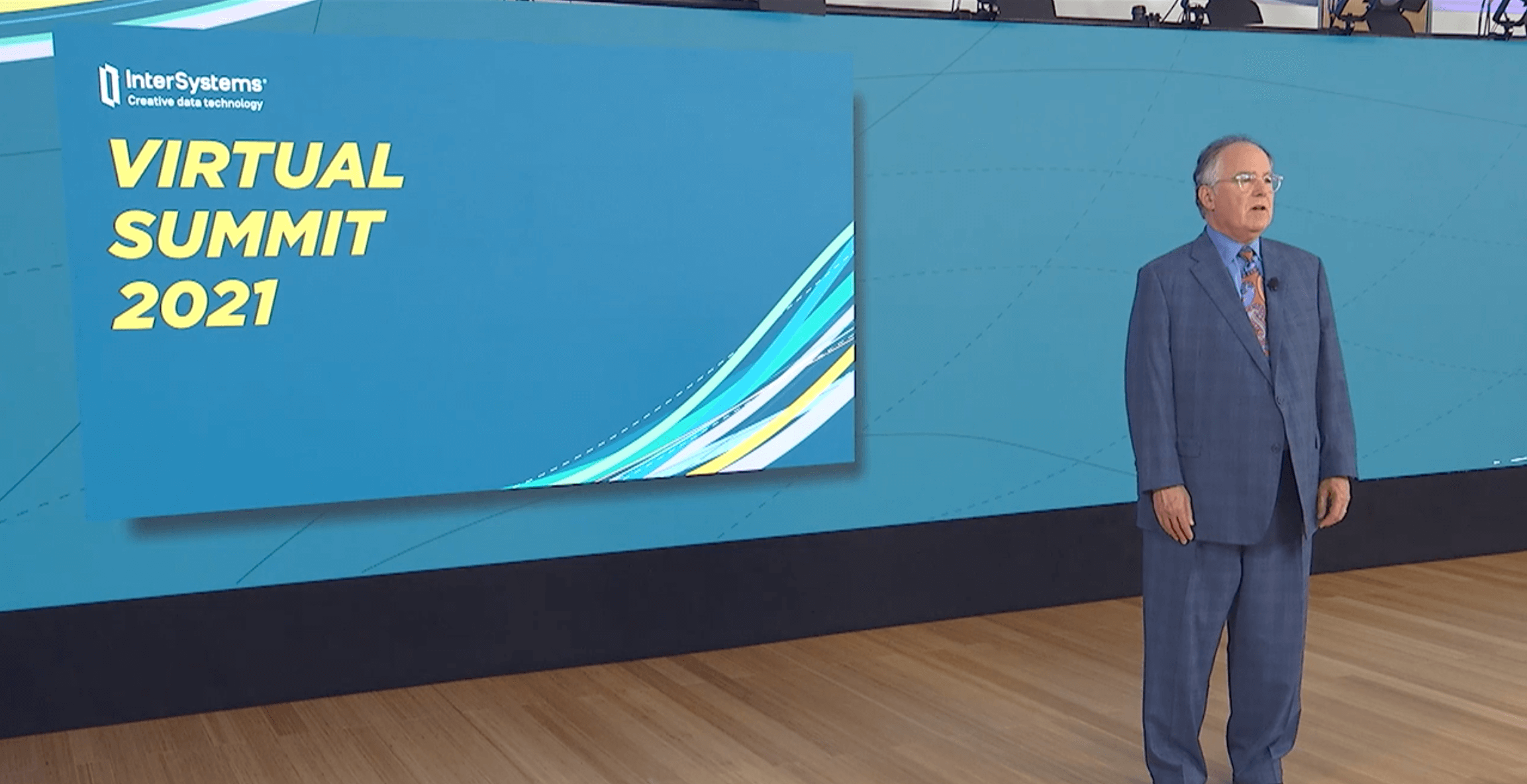
2021 marks the second year of InterSystems’ Global Summit going virtual! We attended and are pleased to provide highlights from some of our favorite sessions. See more in part two!
Welcome Presentation & Analytics Anywhere, Insights Everywhere Keynote


- Date: October 26, 2021
- Presenters:
- Paul Grabscheid, Vice President, Strategic Planning, InterSystems
- Terry Ragon, Founder and CEO, InterSystems
- Overview: Paul Grabscheid opens Virtual Summit 2021 with a preview of the conference presentations, and Terry Ragon describes the overarching need for organizations to invest in building analytics and applications on a unified platform to power efficiency, user adoption, rapid innovation, and value in the coming years.
InterSystems’ Vice President of Strategic Planning, Paul Grabscheid, opened Virtual Summit 2021 with a welcome message. InterSystems has been helping organizations solve their most critical data problems for over 43 years and prides itself on long-standing relationships with customers. As Grabscheid explained, we are now entering an era that will be driven by analytics. This year’s Summit highlights the advances and new offerings that InterSystems expects to help its clients make their data far more accessible, useful, and ultimately, valuable.
Terry Ragon, Founder and CEO of InterSystems, thanked customers and InterSystems employees for rising to the new challenges of the past few years. Years ago, having an Enterprise Data Warehouse that was a month behind current activity was sufficient to be competitive. Today, rapidly growing data from many new sources and increasing demand for data in near real-time from many stakeholders is changing the landscape. We now need better, faster, and more accurate insights in many more places than before. Companies that can do this well will have a major competitive advantage.
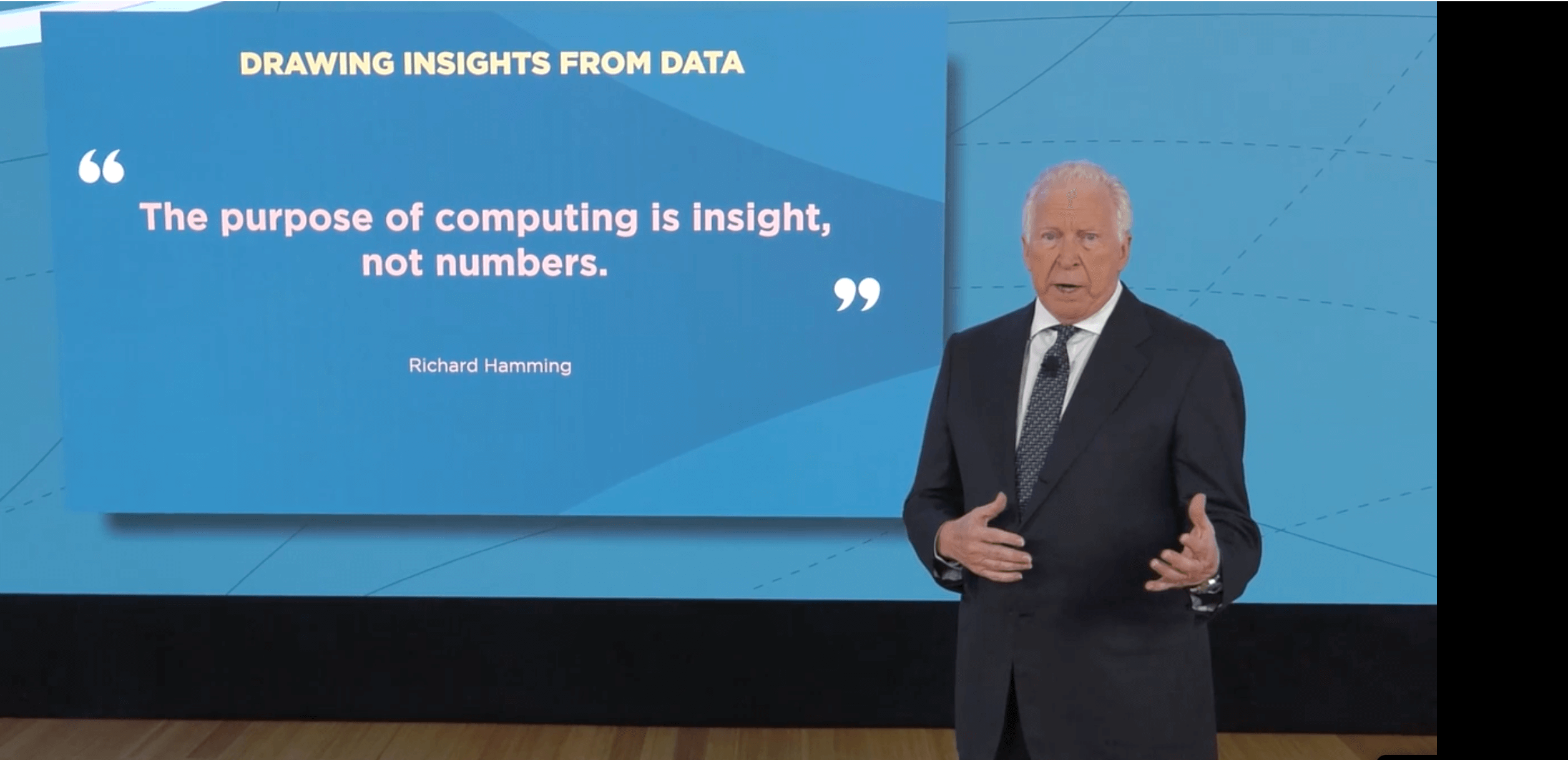
Today’s challenges center around finding ways to obtain useful insights from existing and recent data without causing major upheaval, re-engineering, or negative performance impact. Companies require a unified record database with consolidated views that is always up to date and has clean, healthy data. A complete data platform must provide messaging, efficient databases, and analytics capabilities. The future will require advanced analytics in many places across an organization/ecosystem and the ability to support rapid development of useful and innovative applications that solve problems where they are encountered.
Terry Ragon believes that trust is at the core of any organization’s success. We must be able to trust our data, trust the insights that we derive from that data, and trust our partners. That trust has to be earned. InterSystems strives to build and reinforce the trust that its customers have on a daily basis.
(Re)Building Analytics Capabilities and Culture: Getting Actionable Insights Faster, Better & Cheaper

- Date: October 26, 2021
- Moderator: Michael Schrage, Research Fellow, MIT Sloan School’s Initiative on the Digital Economy (IDE)
- Presenters:
- Dave Anderson, AI Evangelist, Data Robot
- Jana Eggers, CEO, Nara Logics
- Waseem Kawaf, Global Vice President Of Digital Experience, STANLEY Security
- Overview: Michael Schrage from MIT leads a panel discussion on what organizations need to do to turn their investments in analytics into real value for their stakeholders.
In this moderated panel discussion, MIT’s Michael Schrage led viewers through a session focused on understanding the changing roles of those involved in analytics today. It is no longer enough to have a few data professionals locked away somewhere in an IT department trying to sift through data in isolation. Now, data scientists must engage with a broad (and growing) list of stakeholders to better understand the wider context for their organization’s data and the real-world problems that the data can help to solve. It is no longer just about building out data warehouses or offering up data lakes for hoped-for value. Today, organizations must make intentional investments in treating their data teams (and the technology itself) as widely known organizational team members.
Still, organizations should not expect that an investment in a certain technology or simply introducing data professionals to others in the organization will be sufficient. Part of the investment is knowing that it will take time for both the relationships and the quality of the organization’s data to mature. Some questions might not be easily answered today, but by having patience with the process, organizations that invest in analytics, and the people who make analytics happen, there will be results in the long term. Because of this timeline, organizations should be looking for short-term wins along the way to gradually build trust, confidence, and an interest among stakeholders in participating in the process of advancing analytics maturity.

In many cases, organizations will need to think about changing their culture to capitalize on analytics. Too often, organizations buy into technology and perhaps hire a few people to support the investment without making a true commitment to take action on what the investment starts to produce. An organization needs to prepare in advance with a plan for what actions they plan to take based on the answers that emerge from their data. Are they prepared to change workflow? Are they prepared to alter supply chain decisions? If not, investments in analytics are likely to be disappointing. One key tactic to successfully help move analytics forward is hiring the right people. According to the panelists, they are out there. Once the right people with the right skills and energy are hired, they need to be moved into more visible roles in the organization to build rapport, support, and commitment to taking action on analytics output.
The panelists believed it is important to partner with the right feeder programs, such as academic institutions, to secure talent with the “hunger” and energy your organization will need. A critical feature of that talent should be storytelling skills. Data teams should have at least a few user experience or similar types of professionals to help remind the organization of where today’s seemingly smaller insights are likely to lead for the organization and the community it serves. Technical know-how is necessary, but the ability to distill all of the complexities into relatable stories is key. There is now a need to move from “explainable AI,” for example, to “understandable AI.”
In one example, an organization might be able to apply a risk score or an indicator of a patient’s propensity to miss an appointment, but before building out a metric like this and publishing it on dashboards, an organization needs to be able to identify which workflows it is willing to change or enhance and articulate their confidence in actually taking action on the numbers that are produced. Organizations must be willing to take action for analytics to have real value.
Our Vision for Data Platforms: Why you need a Smart Data Fabric

- Date: October 26, 2021
- Presenter: Scott Gnau, Head of Data Platforms, InterSystems
- Overview: InterSystems’ Head of Data Platforms, Scott Gnau, talks about InterSystems’ response to the long-term threat of cobbling solutions together to try to meet near-term requirements and moving toward the concept of creating a Smart Data Fabric.
Currently, we have increasingly complex volumes of data from many new sources. Data is generated, collected, and stored at staggering rates. The combination of increasing demands, variable and changing regulatory requirements, and increasing amounts of data could lead us into thinking that cobbling together solutions for near-term answers is our best solution. However, we need to take a longer view of data quality and see our solutions through the lens of not introducing fragility with quick fixes and short-term customizations.
InterSystems’ product vision is to provide easy-to-use tools to access data from any siloed source, in whatever form it is in, standardize and refine what matters most, and facilitate taking action.
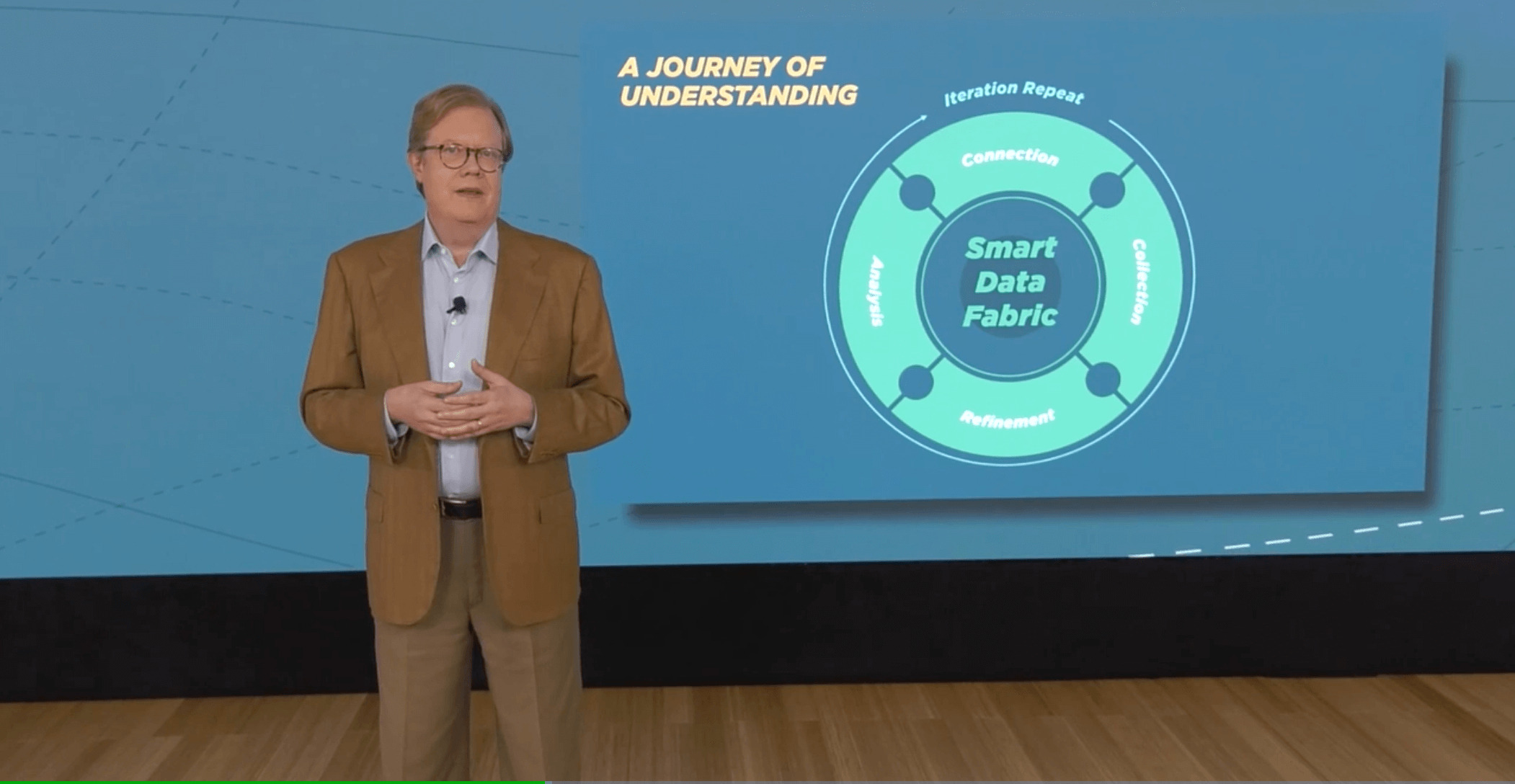
An adaptable solution must work across on-premise environments, the cloud, and individual devices. New data never stops, so InterSystems expects meeting demands to require ongoing, iterative work. Solutions must be scalable, and focus areas must evolve without breaking down or outgrowing a centralized solution.
The concept of a data fabric means threading together data from multiple silos to connect the elements that matter most and refining both the highest value data and its quality overtime to produce a strong weave.
In Gnau’s view, InterSystems’ multi-model database is a core component to supporting this type of long-term flexibility and connections across data silos. A multi-model database enables scalability without adding latency and unnecessary complexity. Perhaps most importantly for customers, InterSystems is doing this within one technology footprint for purposes of stability and lower cost of ownership, which is the goal of InterSystems IRIS. Specifically, less hardware, less software, and fewer copies of data.
Analytics in Healthcare: Opening New Frontiers for Care

- Date: October 26, 2021
- Moderator: Susan Dentzer, Senior Policy Fellow for the Robert J. Margolis Center for Health Policy, Duke University
- Presenters:
- Jaime Bland, DNP, RN, President & CEO, CynchHealth
- Kevin Tabb, MD, President & CEO, Beth Israel Lahey Health
- Alex MacLeod, Head of Global Healthcare Initiatives, InterSystems
- Overview: Duke University’s Susan Dentzer leads a panel of experts in a discussion about the challenges and opportunities for data use in healthcare, with a special focus on differences between the US healthcare system and healthcare data use in other countries.
Susan Dentzer, Senior Policy Fellow at Duke University, facilitated this session. Panel participants represented a major health system, InterSystems, and HIEs. The session began with each panelist describing their respective organizations and some of the challenges they are trying to solve with analytics.
Kevin Tabb talked about Beth Israel Lahey’s challenges in the last year supporting COVID-19 vaccine efforts. When trying to identify higher-risk sub-populations, most people start with age groups, which is easy enough until expectations for patient cohort identification become more complex. For example, filtering populations (accurately) to those with certain combinations of comorbidities can be challenging when details, such as diabetes diagnoses, are not documented consistently or in the same fields, even within a single EHR, not to mention across settings and facilities within a system. Tabb’s staff had to look elsewhere for proxies to identify the right patients, such as selecting patients based on BMI, test results, or other combinations of information.
For their part, HIEs like CyncHealth are helping to track indicators at a state or regional level, such as bed capacity, vaccination metrics, and lab test results in near real-time. Their goal—to support public health emergency planning and decision-making/funding, state mandates, and modify those state-directed decisions over time as conditions change.
Alex MacLeod from InterSystems (Europe) talked about programs underway in places, such as the UK, to integrate services in communities with healthcare to better coordinate mental health services, social care, and voluntary services. (E.g., helping patients to feel less isolated during COVID-19 and providing safe community activities to keep people feeling engaged.) MacLeod noted that the UK is finding interesting connections in their data. For example, they found a strong correlation between elderly frailty or fall risk and whether or not an individual had assisted garbage collection services. Those in certain age groups without assisted garbage collection had a higher risk of falls, based on the data.
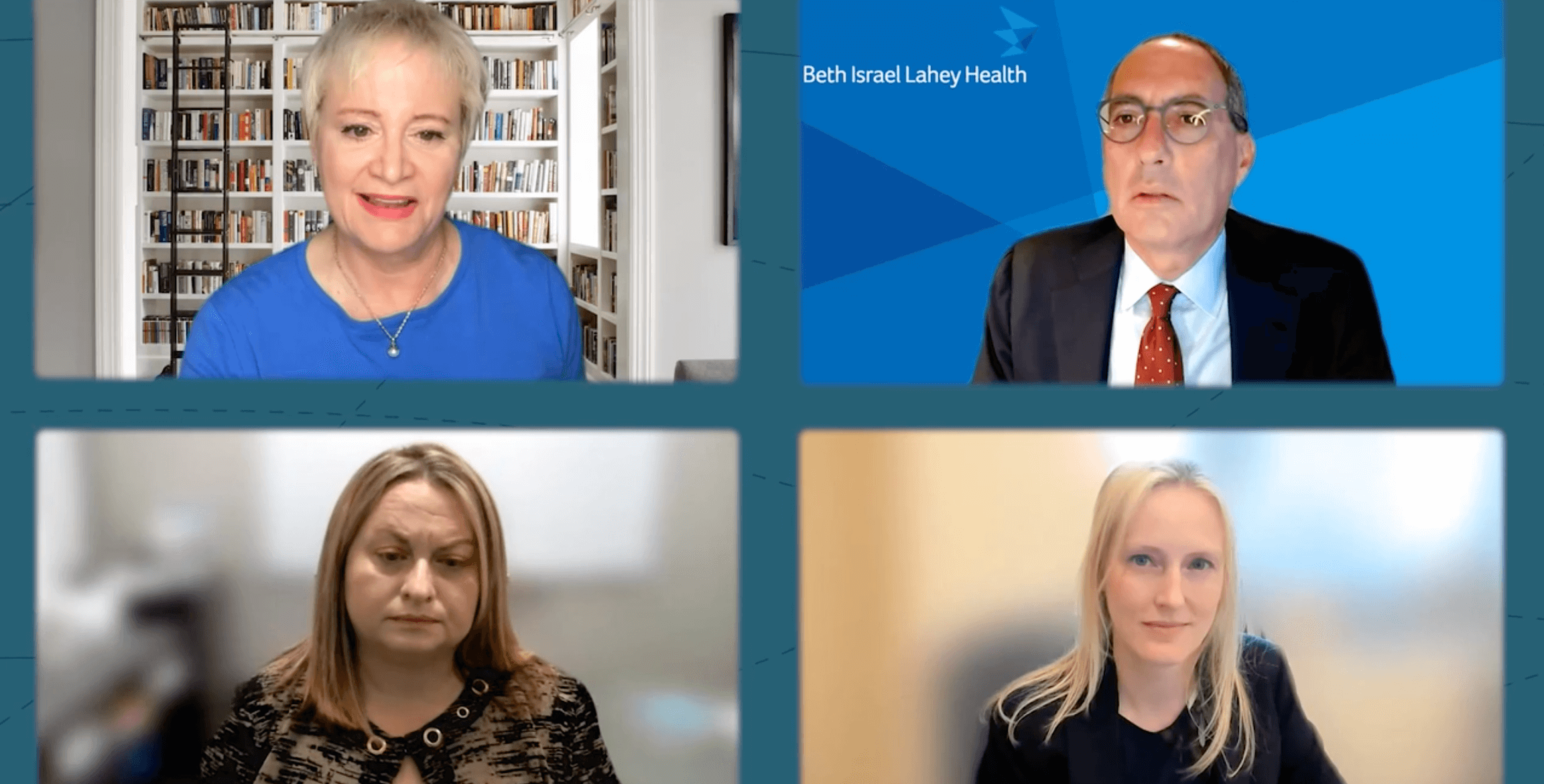
The panelists discussed some of the key differences between healthcare in the US and other countries. According to today’s panelists, one of the biggest differences is that the US lacks a cohesive federal approach to organizing healthcare. Organizations at the local level are left to figure things out themselves as a kind of cottage industry, which can result in a high degree of variation, a vast number of silos, and challenges with aligning to standards for improved data use and coordination at a larger scale. Europe experienced this same kind of uncertainty while coordinating vaccine responses.
According to Dr. Tabb, when thinking about bringing new solutions into the market, companies need to think about solving problems for organizations in more comprehensive ways. One of the big frustrations for leaders like Tabb is technology solutions that appear to solve one problem but actually create new workflows, efficiencies, or data problems in other places within the organization.
The panelists generally agreed that technology is not really the biggest barrier to progress today. The bigger challenges are standards and culture. We still need more education, awareness building, and alignment with standards, whether that is driven primarily at the federal level or by the industry. In most cases, the solution to these problems is not as simple as just making a certain field required in an EHR. Solutions must be more comprehensive and consider related data that can be generated in other settings in a health system and community.
Bland talked about the potential for interconnected data and offered the example of using data to identify populations living close to factories or meat-packing facilities, who, according to the data, are at higher risk of developing certain diseases. Researchers can begin to look at data from well-crafted, standard-compliant ADT messages to help identify and monitor these kinds of sub-groups. When coupled with census and social care data, we can begin to do much more in prospective analyses on topics such as exposure to pathogens or predicting inpatient stays.
MacLeod concluded the session by reminding viewers that we have made great advancements in individual care at the EHR level. We now need to produce value at a population level. MacLeod is encouraged by what she sees as providers begin to talk more about taking time to review population or panel-level information, not only individual patient charts. Now is the time to leverage that interest and willingness to capitalize on the broader data and interconnectedness that we have all been working on.
Our Vision for Healthcare: Getting Value from Data

- Date: October 26, 2021
- Presenter: Don Woodlock, Head of Healthcare, InterSystems
- Overview: InterSystems’ Head of Healthcare, Don Woodlock, shares the results of an InterSystems survey on analytics adoption and talks about the company’s approaches to removing the barriers identified in that survey. Woodlock also announces InterSystems’ TrakCare Innovation Toolkit and InterSystems Client Connection.
Don Woodlock provided a summary of recent survey results among partner organizations. The results showed the following:
- 80% of respondents said their top strategic priority pertaining to analytics is to create and share high-quality analytics across the organization. Woodlock stressed the importance of “share” and the need to make insights available in more places.
- 51% said that data integration and interoperability is the most significant barrier to analytics in the next 12 months.
- Respondents said that the analytics challenges they are facing create long lag times, the inability to scale, and the inability to democratize data.
- Respondents said that they believe these constraints lead to poor decisions, the inability to make timely decisions, and the inability to effectively identify important gaps in care.
- InterSystems is working with clients to find solutions for these challenges and remove as many barriers as possible to help move organizations’ analytics strategies forward.
In the past, organizations tried to rely on solutions provided by EHR vendors. Increasingly, organizations have moved to using independent solutions that come as an empty shell and require a significant amount of data preparation and fine-tuning. InterSystems is working to provide a more comprehensive, end-to-end set of solutions that provide the best of both worlds.
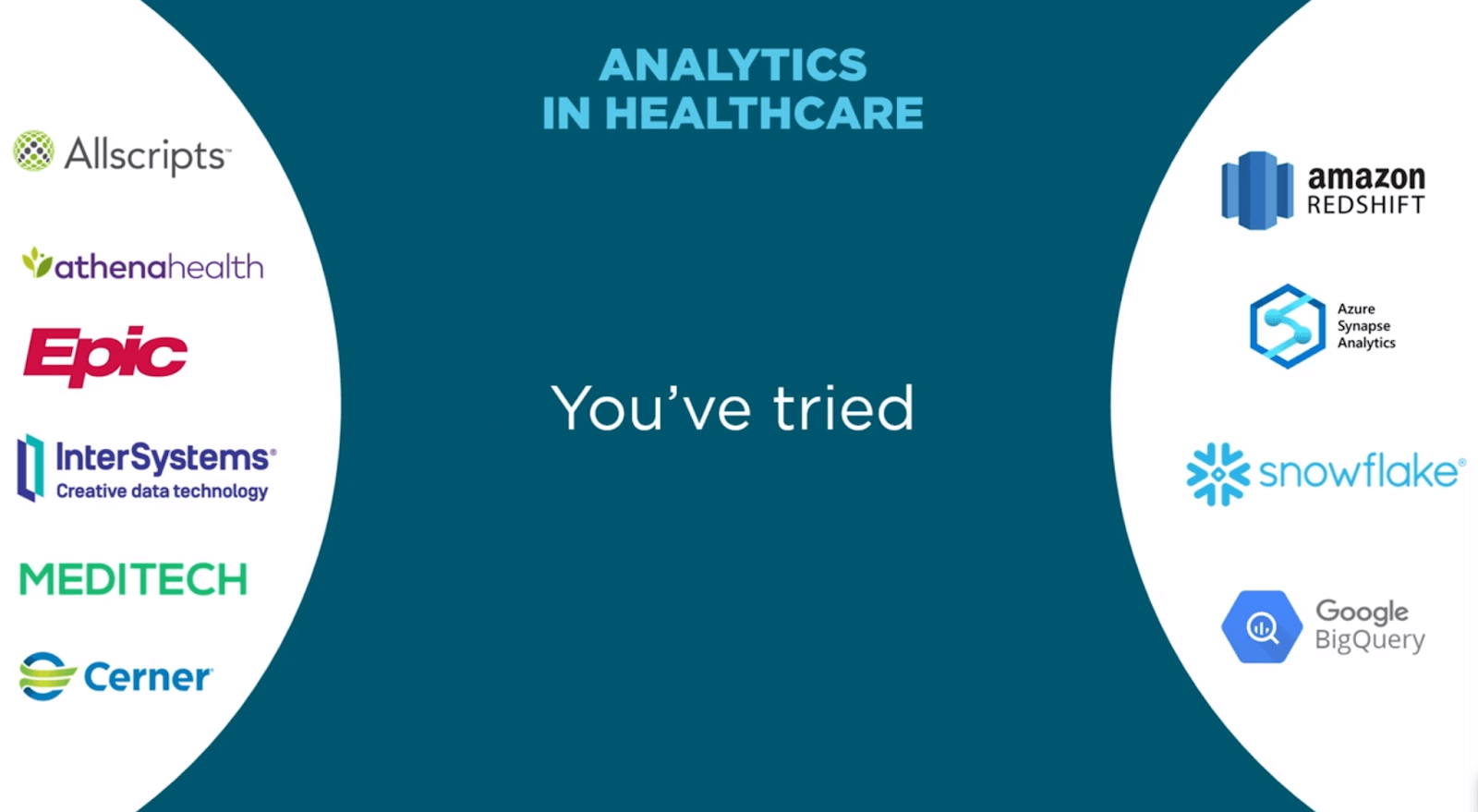
InterSystems’ approach is to centralize clean data, provide the built-in engine to make use of the data and derive insights, and then drive the results of those insights back into existing workflows for clinicians and decision-makers, including directly into EHRs.
One of the first major challenges is connecting to all of the data sources that contribute to the design described above. InterSystems has invested heavily in building a large connector library to make those data source connections as easy and efficient as possible. This ease of use means that InterSystems’ solutions speak any language the data source does, making data extraction and aggregation easy. Data can also be mapped using pre-built data transformations to InterSystems’ Healthcare Data Model, which is a unified “golden” patient record that can run on InterSystems IRIS or populate third party repositories and made available through any number of front-end tools such as Tableau or similar products.
While many solutions stop at dashboard or report creation, InterSystems offers three additional components to help push the results of data aggregation and analytics back into workflows.
- Bidirectional integration. InterSystems has invested in making it easy to connect both to data sources and end-user destinations, such as EHRs.
- Real-time notifications. InterSystems supports delivering notifications to end-users to help improve decision-making and avoid additional clicks/time spent navigating to traditional portals or dashboards. The intent is to move analytics from static or on-demand interactions to deeply integrated insights that appear as part of any number and type of workflows.
- Unified Care Record (UCR). InterSystems leverages its UCR to place clinical data viewing technology into providers’ and care team members’ own EHRs.
Woodlock also presented a brief overview of InterSystems’ new TrakCare Innovation Toolkit to accelerate value creation for clients. The TrakCare Innovation Toolkit:
- Makes TrakCare data available for machine learning
- Enables connection to third-party applications
- Enables creation of new MS Teams solutions, such as chatbots
- Extends TrakCare with SMART on FHIR applications
- Supports development of an organization’s own digital health applications
In addition to this Toolkit, InterSystems is launching InterSystems Client Connection, an online community platform intended to allow TrakCare customers to interact and share information. InterSystems Client Connection includes documentation from InterSystems that will be helpful to the community.
Woodlock encouraged viewers to attend other in-depth focus sessions this week on these topics and concluded this session with a drum solo. The analogy is that drum solos do not necessarily drive the rest of the band, just like analytics can become isolated. To transform your organization, make sure you position analytics as the drumbeat and driver for the rest of your organization, not just a solution for its own sake. Woodlock drove the analogy home by rocking out on the drums, one-upping last year’s guitar solo and proving again that he’s the coolest healthcare IT guy in the ecosystem.

Digital Enablement: A Launchpad for Better Care

- Date: October 26, 2021
- Presenter: Jim Heiman, AVP, Clinical Information Systems, Northwell Health
- Overview: Jim Heiman, AVP of Clinical Information Systems at Northwell Health, discusses the health system’s investment in and strategy for developing its HIE, including examples of compelling rapid technology development successes during the pandemic.
Northwell Health is a prominent health system in New York, whose HIE represents over 14 million patient records. Jim Heiman, AVP of Clinical Information Systems, began this session by listing some of the reasons Northwell Health decided to invest in building their own HIE or aggregated data platform. There was a need for:
- System growth and acquisitions support
- Value-based care reform
- Comprehensive data for care decisions
- Structural and semantic normalization
Other goals included supporting post-care follow-up, care coordination, chronic disease intervention, optimizing throughput, and participating in clinical trials.
Heiman discussed the HIE’s timeline:
2013 – Comprehensive Health Record
Released internal HIE, featuring the unified Comprehensive Health Records with embedded Clinical Viewer (CV) in enterprise EMRs
2014 – Clinical Event Notifications
Added intelligence on the integration wires to detect events a clinician would subscribe to
2015 – High-Value Document Exchange
Completed specific integration to facilitate acute to outpatient transitions of care, targeting the most beneficial clinical data
2016 – Patient List App
Built workflow optimization tool leveraging rules to create smart patient lists for follow-up and administer interventions
2017 – Active Analytics
Consolidated data platform to query data in bulk breaking down internal silos
2018 – Enterprise APIs & Java Messaging
Unlocked data for innovation enabling additional in-house development capabilities to emerge
2019 – Regional Interoperability Strategies
Achieved data interoperability between caregivers in each region, in advance of enterprise platforms, with stand-alone or integrated Clinical Viewer
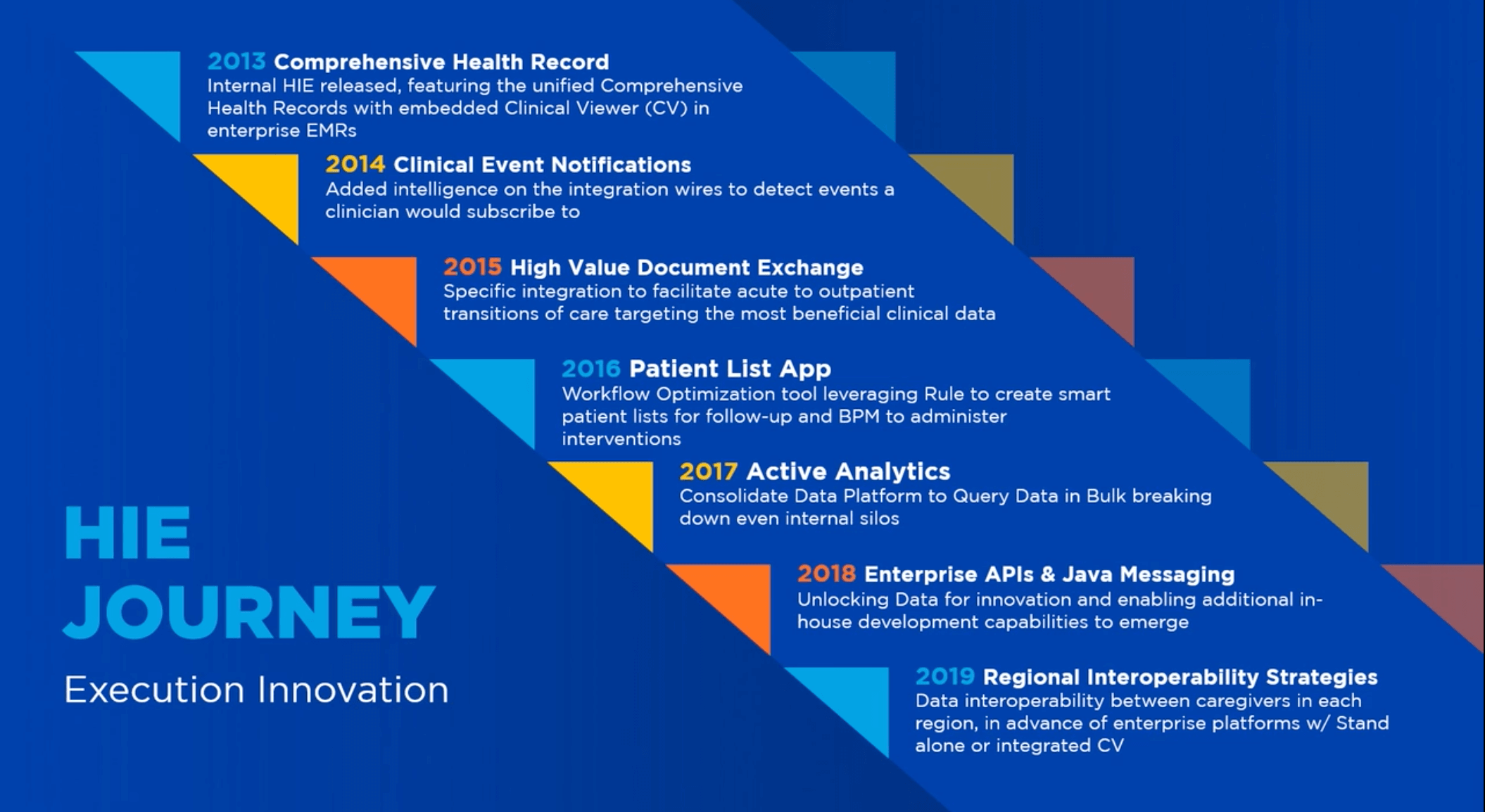
Northwell Health employs a four-part HIE strategy that involves:
- Unlocking data silos
- Empowering organizational efficiency
- Synchronizing enterprise data
- Engaging with community
In recent years, the focus has been on internal growth and value creation. Now, Northwell Health is shifting its focus to engaging external stakeholders. Northwell Health’s HIE represents 14 million patient records from 30 connected systems with over 300 interfaces and more than 28,000 users.
Heiman talked about Northwell’s role in the pandemic response and shared a number of video clips highlighting the heroic work of frontline healthcare workers. Heiman expressed his thanks to all of those who provided great care during the pandemic and also thanked the support staff that helped behind the scenes.
Heiman discussed Northwell Health’s efforts to support COVID-19 testing and the resulting work to optimize lab result delivery and critical pathway development. Northwell Health enhanced its tools and processes to ensure that both providers and patients had access to information as soon as it was finalized. Northwell Health delivered not only clinical information but guidance and education for patients as well.
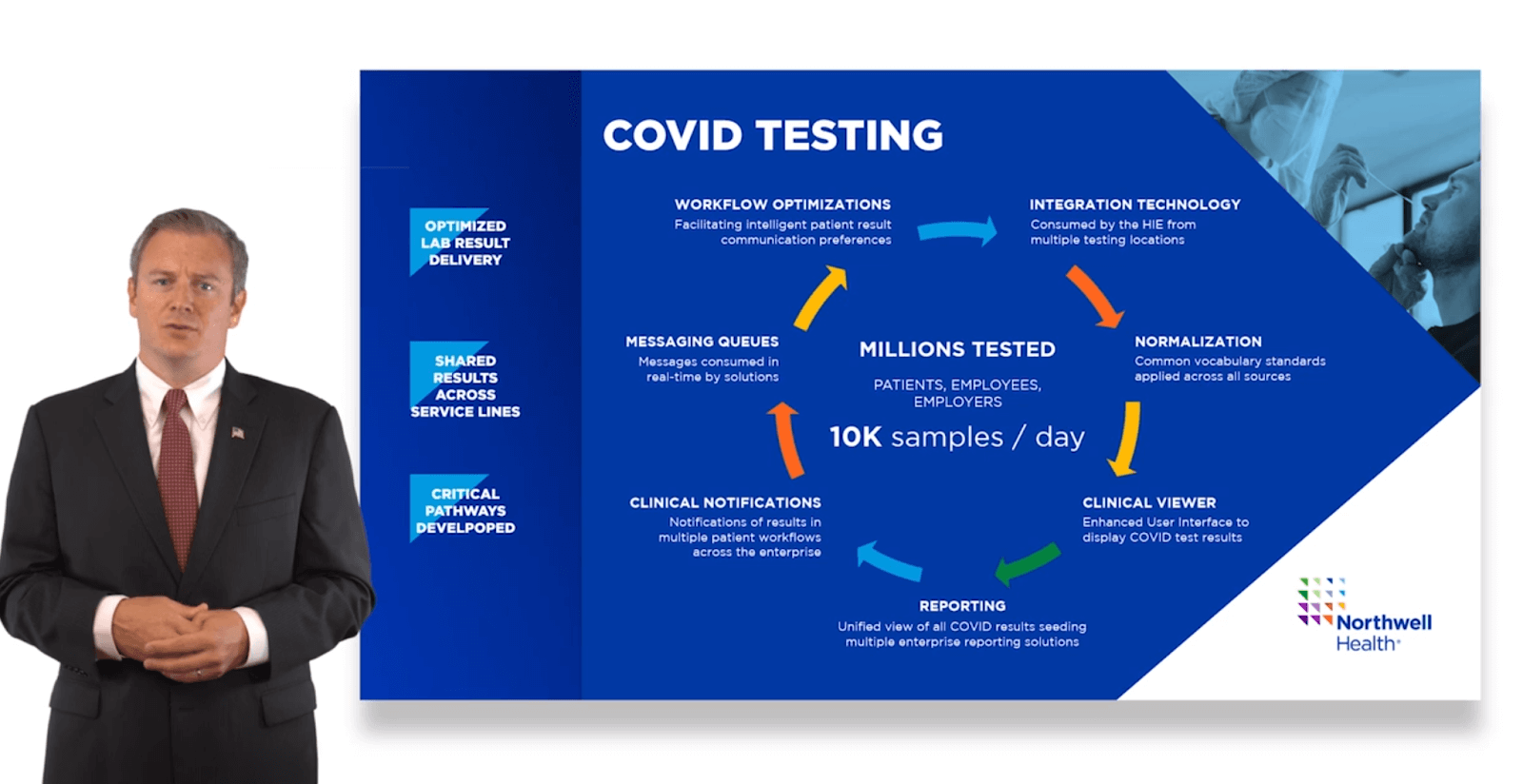
Heiman discussed two other high-value offerings from Northwell Health. One includes MAB infusion referral patient list creation and notifications to keep ordering providers up to date on the completion of infusions. The other involves scheduling and rescheduling tools for patients related to vaccines that bridge back to billing systems on an automated basis.
Northwell Health developed and deployed 35 new critical workflows and released over 100 enhancements in response to COVD-19. Most of these were delivered within hours or days of the original request and were completed in seamless collaboration across teams that supported a shared mission.
The speed of development and value creation at Northwell Health during the pandemic is remarkable, but Heiman sees these advances as just the beginning of what is to come post-COVID. Heiman discussed plans to incorporate patient device data, automate scalability, further reduce waste and unnecessary interventions, and optimize continued system and infrastructure expansion.
Keynote Customer Success Parts 1 and 2

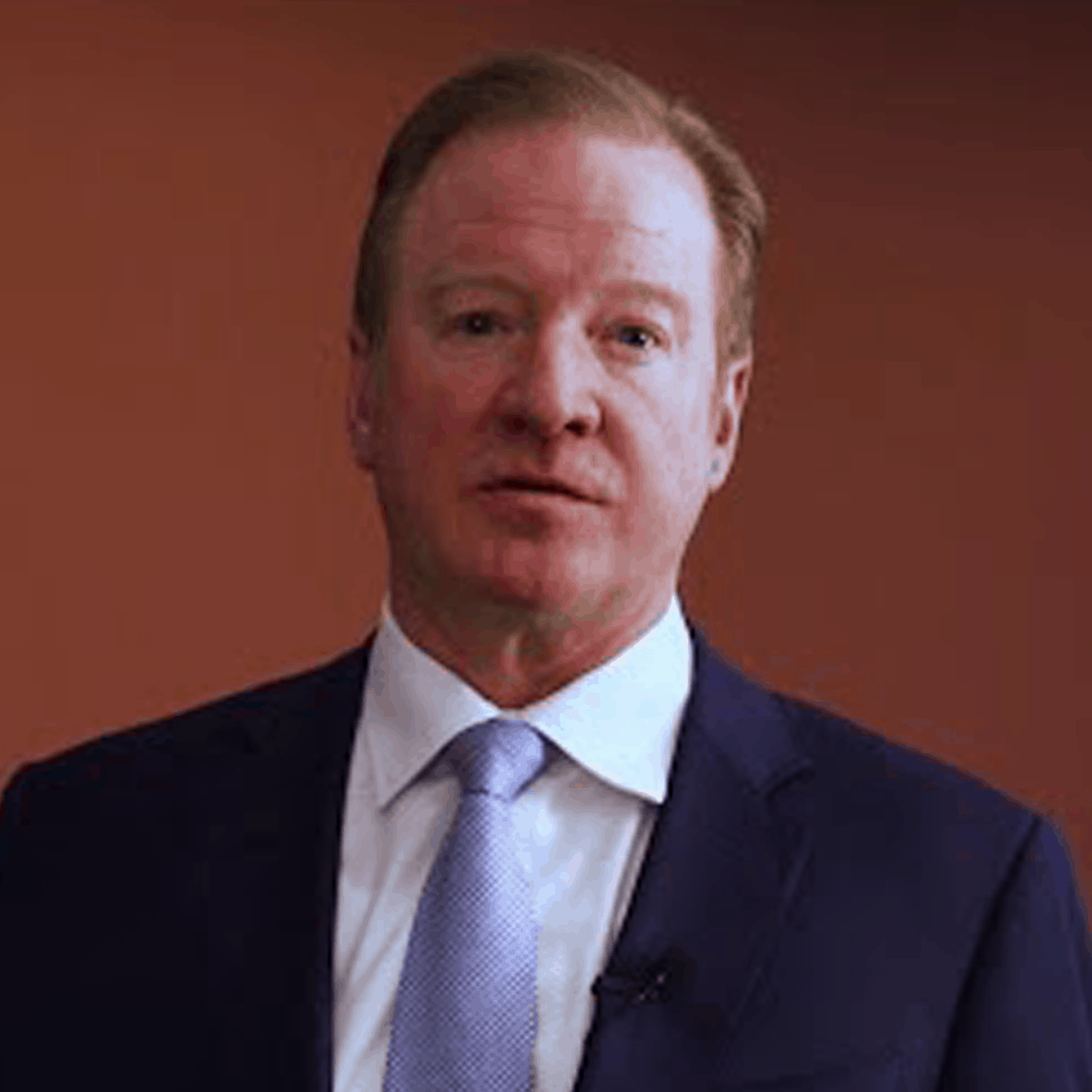
- Date: October 27, 2021
- Presenters:
- Lisa Ford, CSP, CPAE on Customers as Partners: Build Loyalty & Repeat Business
- John Paladino, Head of Client Services, InterSystems
- Overview: Customer experience (CX) is a top priority for InterSystems and many of its most successful customers. Lisa Ford, CSP, CPAE, discusses what separates companies that excel and enjoy great success from those that struggle. InterSystems VP of Client Services, John Paladino, shares his passion for customer success and the approaches he takes at InterSystems to create and maintain a model support organization.
Lisa Ford is an expert on customer experience, and managing customer relationships is a critically important theme of this year’s Summit. Ford described real-life examples of organizations that had the right ideas about customer engagement and loyalty but had trouble taking specific action to operationalize those ideas, ultimately falling short of earning customers’ trust. Everything that companies do can erode, maintain, or strengthen customer trust and loyalty.
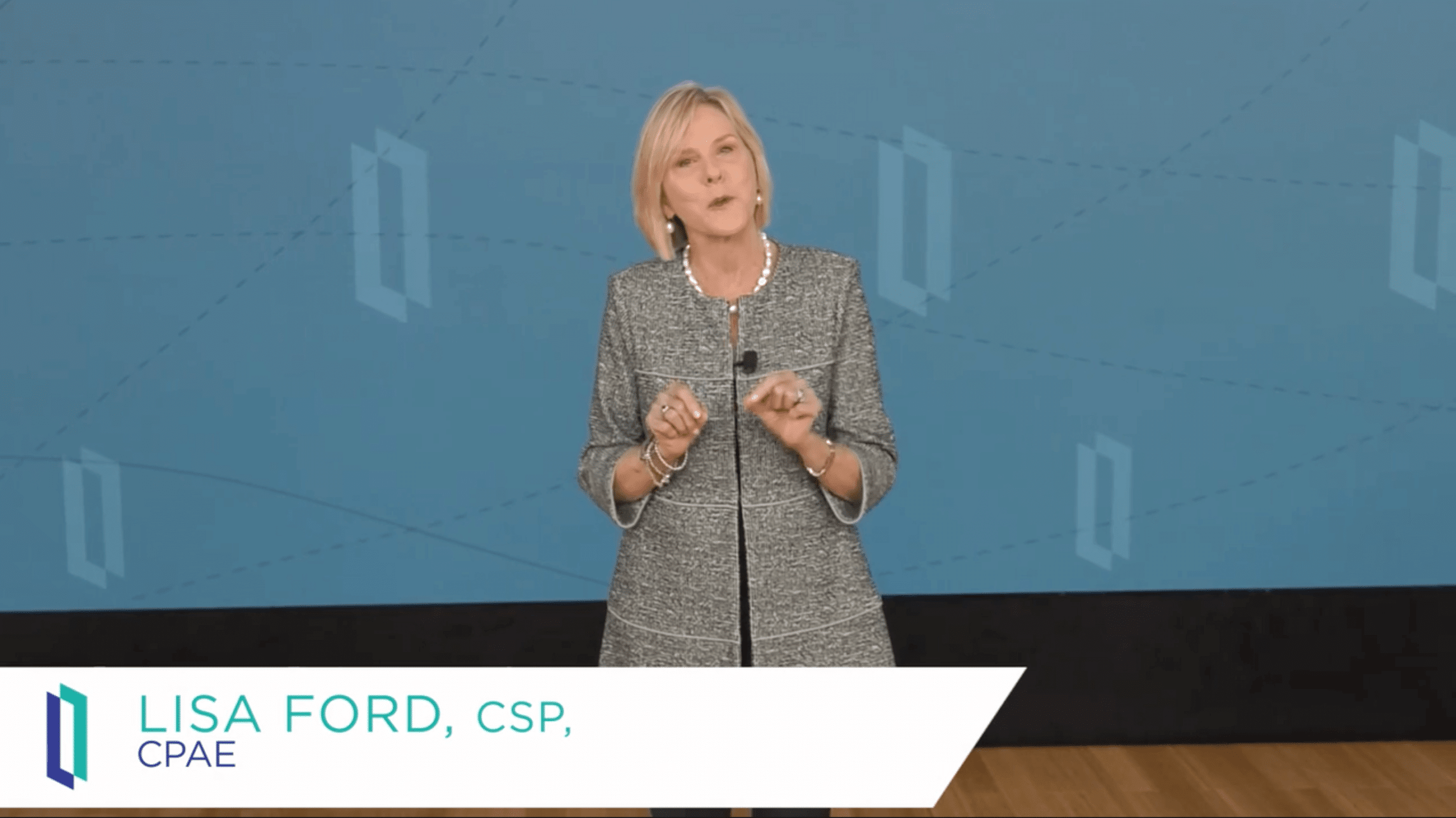
Very often, dealing with customers devolves into “transactions.” Ford argued, however, that the best and most successful companies find ways to give customers what they really want: relationships with companies and brands. Perhaps the most compelling story Ford offered during this session came from the convenience store chain 7-Eleven. The CEO visited a 7-Eleven store location near Chicago to learn what made that site sell more coffee than any other location. As the CEO took inventory of the potential factors leading to the store’s success in selling coffee, he found a simple root cause—a woman who worked at that location named Dolores. She knew customers’ names, asked about their families, stayed up to date on kids’ sporting events, and was, in effect, a family member to many people in the community. Ford explained that customers were not just buying coffee from that store; they were coming to see Dolores and happened to buy coffee while they were there.
According to Ford, there are three main things companies should work on:
- Customer experience deepens the relationship customers have with your organization.
In a Gartner study, company leaders were asked what they believe they need to compete on. A hefty 89% said they expect to compete mostly on customer experience. Just a few years ago, only 36% of respondents said the same thing. - Know the customer and show them that.
The 7-Eleven example above illustrates this point. - Successful companies consistently help customers solve their problems.
Amazon provides a helpful example here. The retail giant learned that customers weren’t just going to their website to buy things—they were also there to research, compare, and look for recommendations. Amazon put tools in place to help guide customers with customer reviews, recommendations, related product choices, and information about products to help them compare options (e.g., price per unit, ounce, pound, etc.).
Ford concluded with an example of staff at Ritz-Carlton who organized daily standup meetings to help employees stay energized and focused on always looking for ways to improve the customer experience. Other companies attempt watered-down versions of these kinds of commitments, but they are often less successful and end up being abandoned. According to Ford, the secret to success is prioritizing action to put the customer first every day: “Your daily discipline will determine your destiny.”
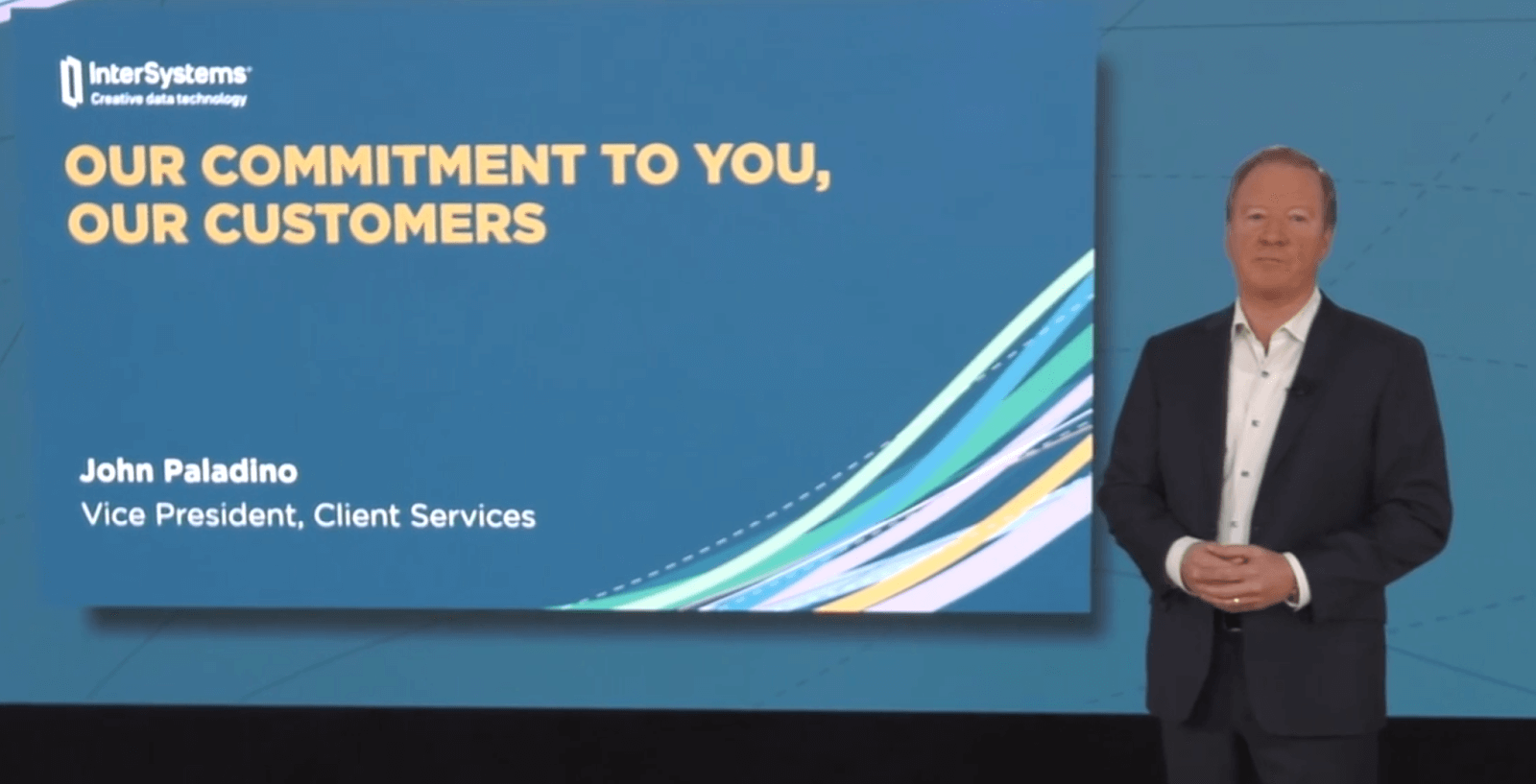
John Paladino, InterSystems’ Vice President of Client Services, told viewers about the early influences that led to his career choices. At a young age, Paladino had a traumatic experience. In order to cope, Paladino found that helping others made him feel better. He turned this coping mechanism into a lifelong passion and found the perfect fit for a long-term career at InterSystems—in large part because of the company’s clear passion for helping others.
Paladino provided a few examples of that commitment and passion. In one example, a client in the pharmaceutical industry made the decision to model their own organizational redesign after InterSystems and asked InterSystems to participate in their change efforts. In another example, a trading platform that uses InterSystems’ products experienced potentially overwhelming growth. In order to make sure the company managed that growth successfully, InterSystems flew dedicated staff and Paladino himself to the customer over a period of time to stay ahead of that growth and lay the foundation for exceedingly rapid scaling. The company has, in fact, experienced tremendous success.
InterSystems continues to invest in support talent and will continue to do so to help clients solve their most pressing challenges. Paladino believes in hiring the right people, putting them in the right environment to be autonomous and succeed, and giving them the tools they need to do their best work. As a general rule, Paladino said he looks for the following traits when hiring someone new:
- New hires should have a high aptitude, intelligence, and a high degree of initiative. Paladino looks for people who are not afraid of new things or taking action.
- Successful applicants will have a clear passion and energy about something in life. For Paladino, this is easy to identify.
- Professionalism is required. Paladino must be confident about putting any new hire in front of long-term and highly valued customers.
Paladino invited anyone who would like help shaping their support team to contact him directly. Great customer support is his passion, and he is always willing to share what he has learned.
Keynote TrakCare: What’s New and Next

- Date: October 27, 2021
- Presenter: Dimitri Fane, Product Director, InterSystems
- Overview: Dimitri Fane, Product Directior at InterSystems, hosts a team-assisted demonstration of TrakCare features following an example patient journey and discusses new features for the solution.
If you have studied biological evolution, you know that it does not happen at a constant rate. Species exist in stasis for a while, then accelerate change to adapt to something like environmental disruptions. We have experienced such a punctuation event in the form of COVID-19. The pandemic has forced systems to change and change quickly.
Dimitri Fane, InterSystems’ Product Director, said that InterSystems TrakCare highlights the core company belief that a truly unified platform must be built for a changing world, and he listed key factors that should be considered when developing a product strategy. These include:
- Improving coordination of transitions of care
- Measuring and improving quality
- Reducing pharmacy stock waste
- Making better-informed decisions
- Caring for target populations
- Engaging patients and driving loyalty
- Deploying a new model of care
- Streamlining care processes
- Continuing to comply with new reporting or regulatory requirements
- Identifying risk for early intervention
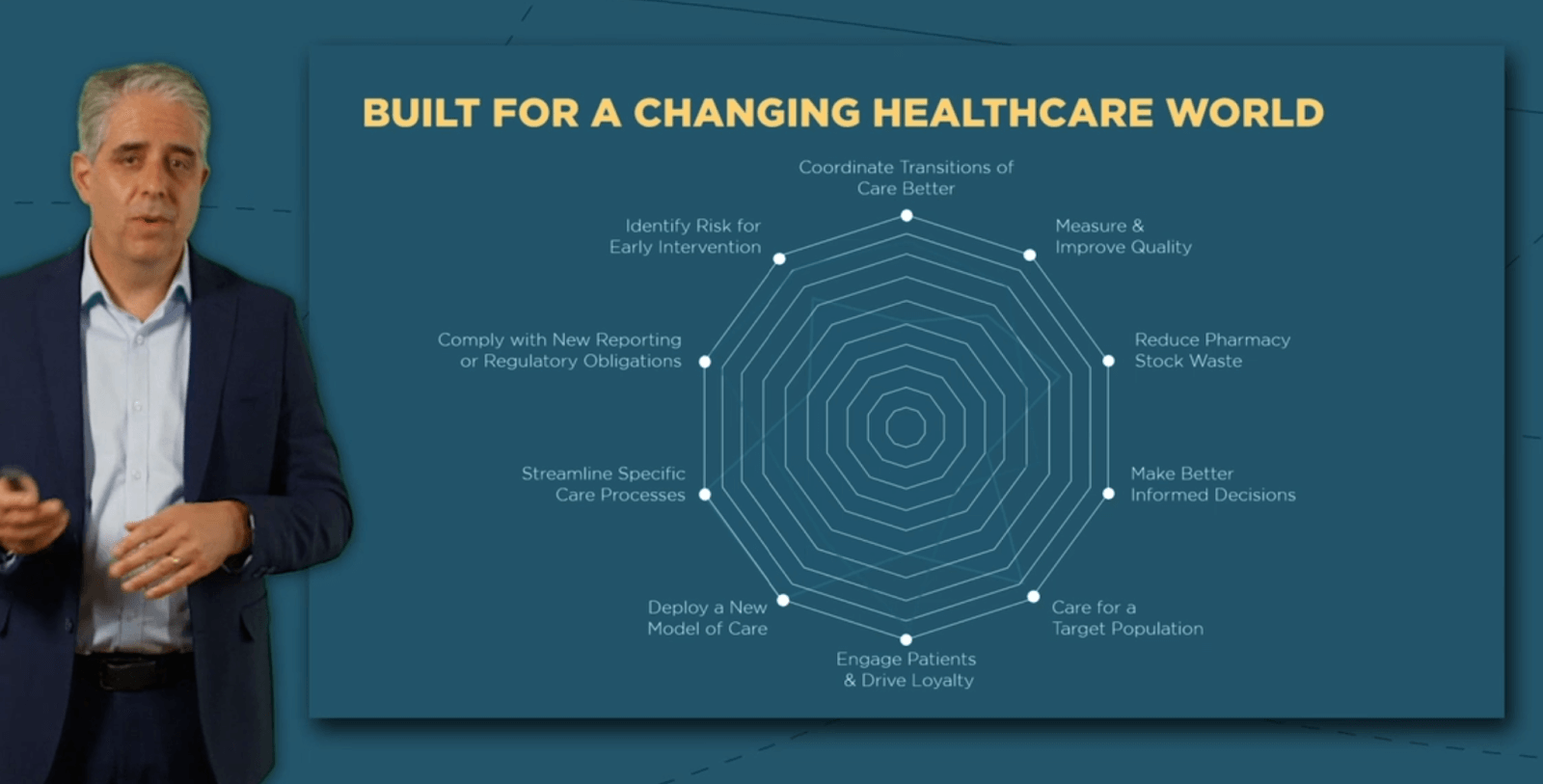
Organizations can experience pressure from any or all of these factors. For these reasons, digital systems need to evolve with organizations as they experience these kinds of pressures to varying degrees over time.
According to Fane, InterSystems employs three guiding principles or pillars of agility and resilience:
- Significant investment in interoperability to aid ease of connecting to the best and most needed data sources.
- A passion for customer experience to drive deeper adoption and satisfaction.
- Responsive architecture to facilitate rapid innovation for today and the future.
Fane discussed some of the benefits of the new TrakCare Innovation Toolkit, including removing barriers to the rapid development of meaningful solutions, allowing data access through FHIR, and making it accessible to more organizations through low entry barriers, including IRIS Community Edition.
Fane and his team walked viewers through an example patient journey with team members playing the roles of a patient and various care team members. In this example, the following played out:
- Care teams create custom patient lists based on criteria such as diabetes diagnoses or proxy indicators.
- Providers and care team members use TrakCare to explore patient health factors that contribute to their inclusion in a given defined patient list to monitor; this includes viewing details, such as a family history of diabetes or recent blood glucose levels.
- A care team member adds clinical notes, such as observations about weight change or other relevant information that the rest of the care team would benefit from knowing about the patient.
- Based on inclusion criteria, a provider uses the software to invite a patient for specialized care, such as a diabetes clinic, by email, without leaving the application.
- The patient then receives the email invitation and might click or tap a link to view the invitation.
- The patient logs in and sees that no appointment is scheduled yet, but can check availability and book their appointment through the application.
- Confirmations can then be handled by multiple modes such as phone or email.
- A clinical supervisor logs into their view of the application prior to patient arrival and can manage provider schedules such as by moving blocks of patients between providers to smooth out overbooked providers with underbooked providers, which improves health system operations as well as improving the patient experience by reducing unnecessary additional wait time.
- An endocrinologist then views the patient’s information. They can look at the patient’s diabetes history and clinical notes from other care team members, as well as previously ordered tests, results, and comments. The provider can easily find existing care plans or start a new one. Care plans can include patient education, screening, and prevention measures. Providers can also leverage order sets from defined critical pathways for diabetes based on the patient’s risk profile and can interact with referral options, such as removing smoking cessation referrals if the patient does not have a history of smoking.
- In today’s example, the patient later visits the Emergency Department due to feeling faint and dizzy. The ED physician can see that the patient is enrolled in a critical pathway for diabetes and review notes from the care coordination and endocrinologist. The ED provider can place orders directly from the same user interface and use “Order Favorite” for frequently used orders. All of this activity is recorded in the medical record.
- We then meet a pharmacist who sees the patient’s record and performs medication reconciliation. The pharmacist knows that the average diabetic patient can be on eight or more active medications. TrakCare can import medication data from national databases using FHIR and can review prescribing and dispensing information. It can also record information, such as how the patient’s compliance with taking the prescribed medications.
- An ED nurse might then also log in to review the encounter record. The nurse can check the patient’s history and open a new encounter record to begin documenting on the patient. The nurse might also use TrakCare’s visual clinical timelines to see data plotted over time, such as blood glucose monitoring (different departments like Labor & Delivery and Pediatrics can have different clinical timelines to view). Users can move around the charts and interact with them to explore data in more detail. The nurse in this example can then enter another blood glucose reading to the encounter and to the timeline without leaving the application, as well as update other details such as an administered flu shot.
- TrakCare also features Tasks, which can be assigned to care team members. Those members can follow up on Tasks until they are completed and can filter their view to see all patients where they have an open Task to complete.
- For follow-up, a diabetes specialist can use the software to launch a virtual appointment with the patient (in this case, using MS Teams) and review and update documentation while speaking with the patient.
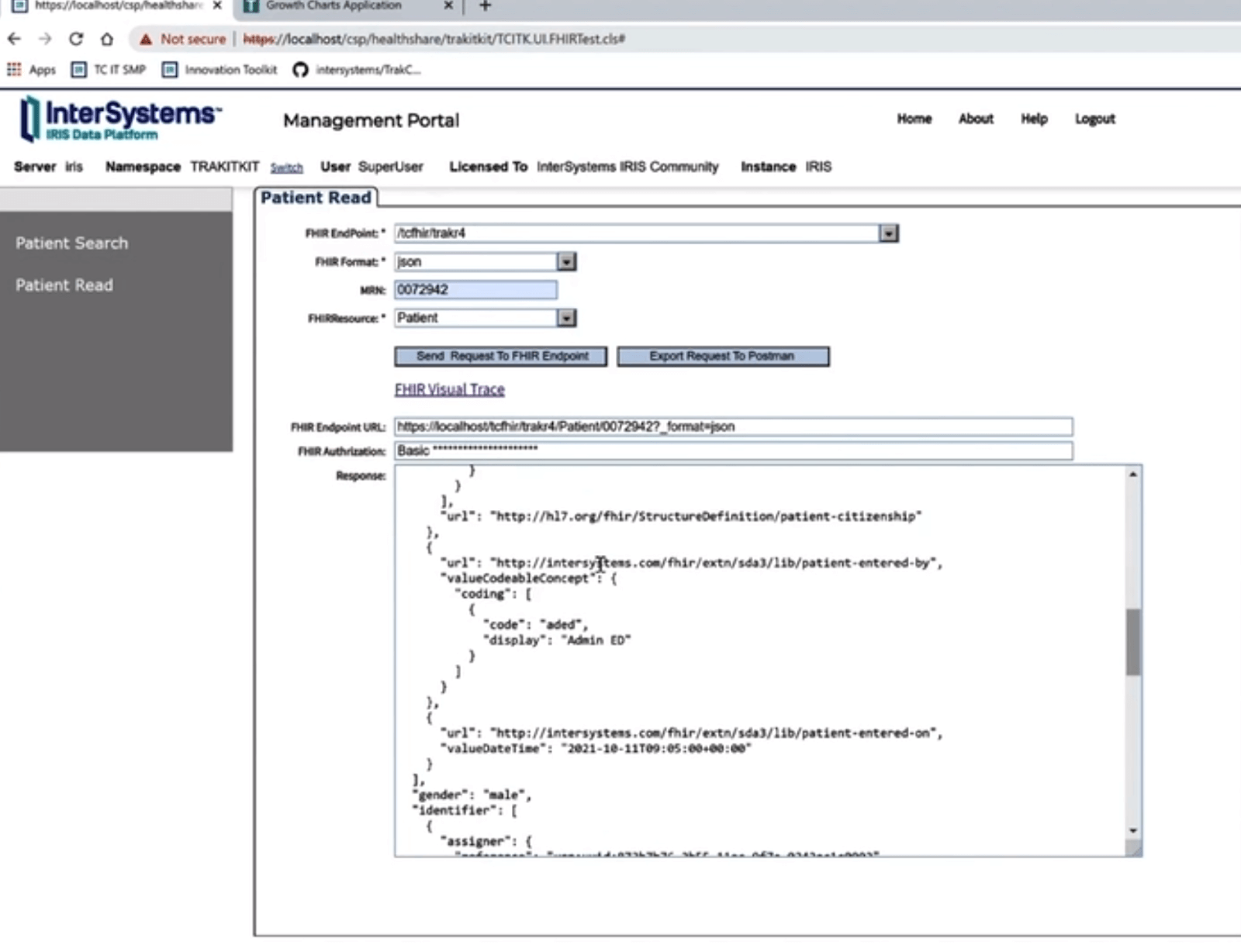
Today’s demonstration uses a few new features for TrakCare, including the visual clinical timelines and FHIR for medication data. Both are significant investments in the future of interoperability.
Presenters also shared a demo of quickly creating a new SMART on FHIR app to link available TrakCare data to predesigned visual displays to organize and interpret trends.
Fane reminded viewers about the new InterSystems Client Connection community. Most viewers who are InterSystems clients can access this with their existing credentials. New accounts can be set up as needed. In order for organizations to take advantage of the technology shown in this session, however, IRIS 2020 or newer and staying current with patches is all that is required.
Keynote HealthShare: What’s New and Next


- Date: October 27, 2021
- Presenters:
- Jonathan Teich, MD, Product Director, InterSystems
- Lynda Rowe, Senior Advisor – Value Based Markets, InterSystems
- Matt Spielman, Product Manager, InterSystems
- Jeremy Davis, Product Manager, InterSystems
- James Derrickson, Product Manager, InterSystems
- Leah Goddard, Product Manager, InterSystems
- Overview: Jonathan Teich, MD, hosts this update session on HealthShare. Five speakers cover multiple important aspects of enhancements for this core InterSystems solution, including compliance with CMS Interoperability requirements and No Surprise Billing, FHIR for the Unified Care Record, maintenance and cost reduction efforts, CareCommunity and forms enhancements, and information about the Provider Directory.
Dr. Teich opened the session with an overview of some of the factors influencing InterSystems’ solution development and areas of focus, particularly for InterSystems HealthShare. Teich listed the following use cases:
- Data sharing regulations
- Care coordination and referrals
- Social care and social determinants of health
- Clinical quality measures with time to intervene
- Risk and opportunity detection
- High-quality big data from mergers, registries, genomics, CER, devices, and monitors
- Clean data for analytics and machine learning
- Community surveillance, telehealth, home care, and chronic conditions
- Extended data, including supply chain, public data, and non-patient data
- Multi-site clinical trials
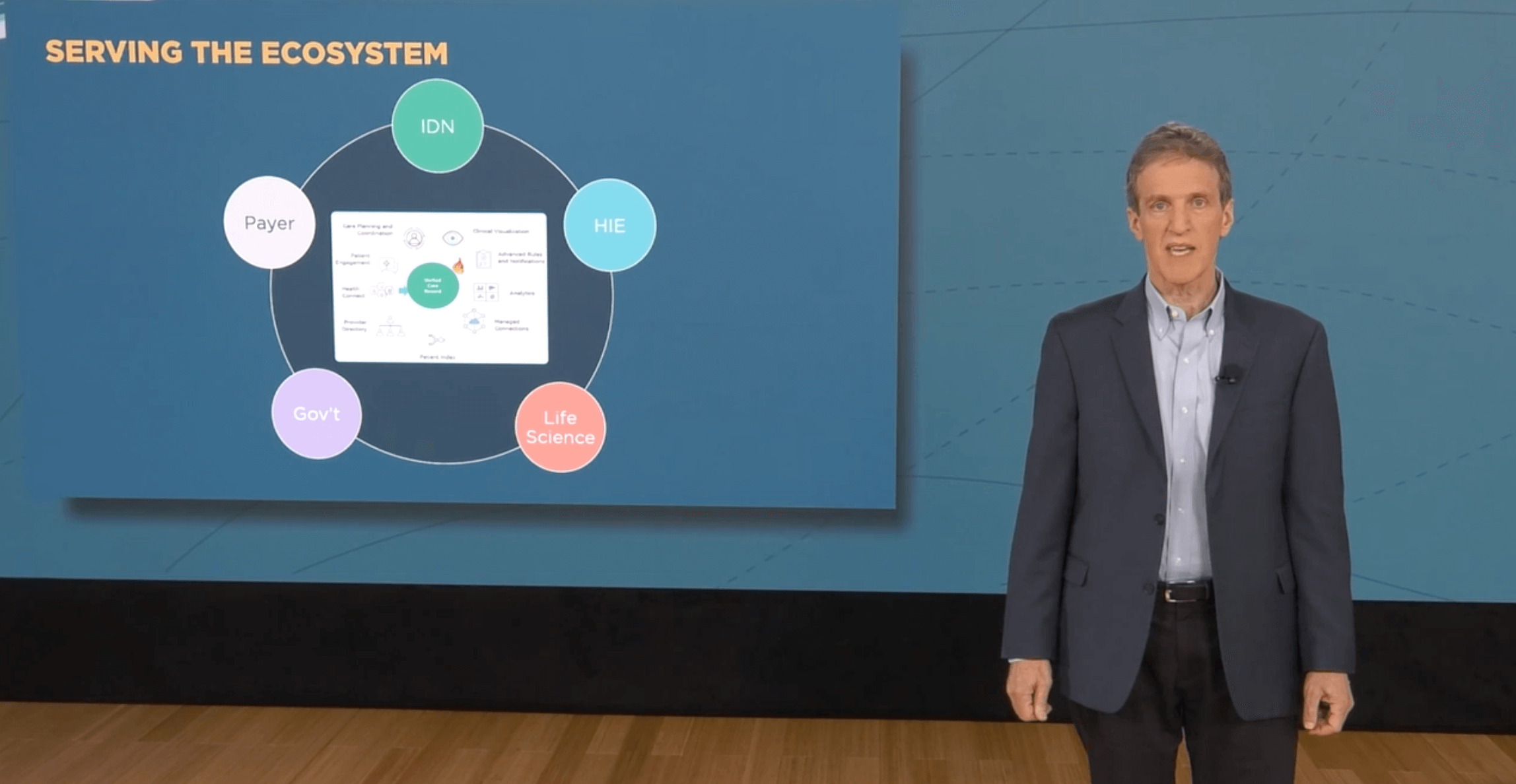
InterSystems continues to work on solutions for Integrated Delivery Networks (IDN), Health Information Exchanges (HIE), Life Sciences, Government, and Payers as broad categories.
Lynda Rowe presented a summary of regulatory requirements and InterSystems’ work to assure compliance for affected clients. The list of work includes:
- CMS Interoperability Rules (9115-F):
- Event Notification for Providers (May 2021)
- Patient Access API (July 2021)
- Provider Directory API via FHIR/PDex (July 2021)
- Payer-to-Payer Exchange using USCDI (TBD 2022; requires replacing Common Clinical Data Set with USCDI)
No Surprises Billing:
- Provider Directory Provisions (January 2022)
The goal of No Surprises Billing is to better track payer membership to avoid situations where providers are no longer in-network, which can generate bills that patients are not expecting.
InterSystems completed most of the work for the following responses to these requirements in 2020:
- FHIR 4.0 – Support for US CORE profiles
- USCDI data elements in SDA
- CPCDS data elements in SDA
FHIR mappings added in 2021 include:
- US CORE
- CARIN for Blue Button (CPCDS Data Set)
- PDex (InterSystems HealthShare version 2021.2)
Matt Spielman talked about InterSystems’ efforts to modernize FHIR-related user interfaces, which included removing as many barriers as possible to FHIR adoption, streamlining storage, and adding profiles in a few clicks.
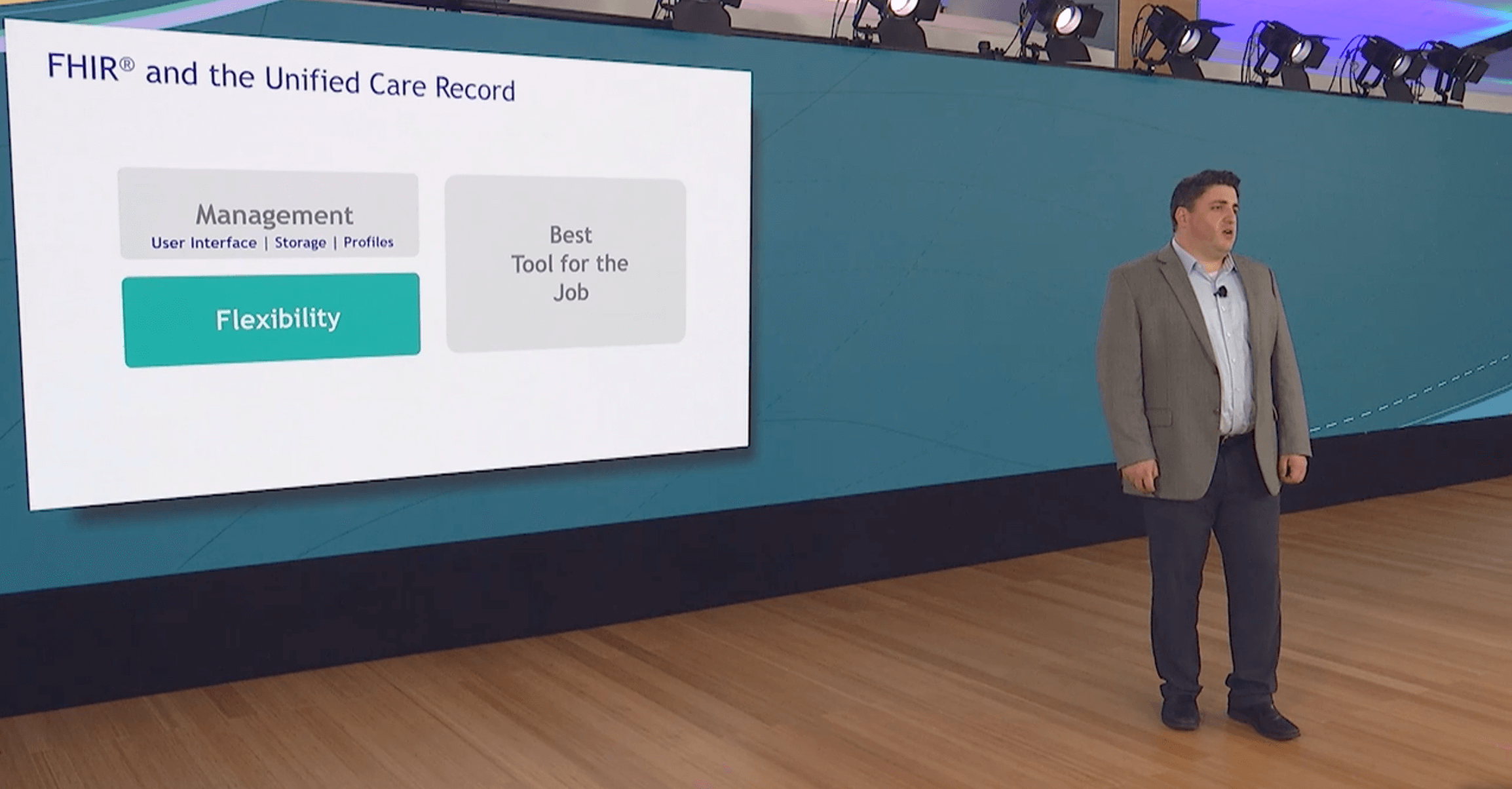
The most common use case for FHIR is still individual patient information. Tools exist at larger population levels, such as HealthShare Health Insight, but there is a level in-between that requires attention. Specifically, smaller sub-populations, panels, or registries of patients with common criteria that fit into lists. To support this missing piece, InterSystems has worked to support multi-patient FHIR queries without the need for SQL or detailed knowledge. With this functionality, organizations can begin to answer questions like, “Which patients with heart failure had an encounter within the past two weeks?”
Jeremy Davis described enhancements to InterSystems HealthShare to facilitate both importing and exporting shared care plans for patients, including the ability to view and track Tasks until they are complete as part of a collaborative care team approach.
James Derrickson shared updates about InterSystems’ Provider Directory, which should serve as the source of truth for provider information and can be pushed to a FHIR repository or external systems.
Derrickson talked about increased control over Forms access, including role permissions to control the amount of information viewable to certain users. For example, some users might not need to see providers’ background information or sanctions.
InterSystems knows that after a system is live, cost is always a major consideration. Leah Goddard spoke about what InterSystems is doing to help control both time to value and the total cost of ownership.
InterSystems is focused on three key areas:
- Implementations – Using default data transformations such as default HL7 for faster onboarding of new data feeds
- Maintenance – Lowering storage costs and improving performance and scalability
- Upgrades – Improving guidelines and reducing downtime
The time it takes to work through transforms can be significant. InterSystems’ goal is to standardize transforms to reduce up to 90% of the custom transform work required as part of many integrations. In the future, InterSystems also expects to simplify deployments with more automated background processes.
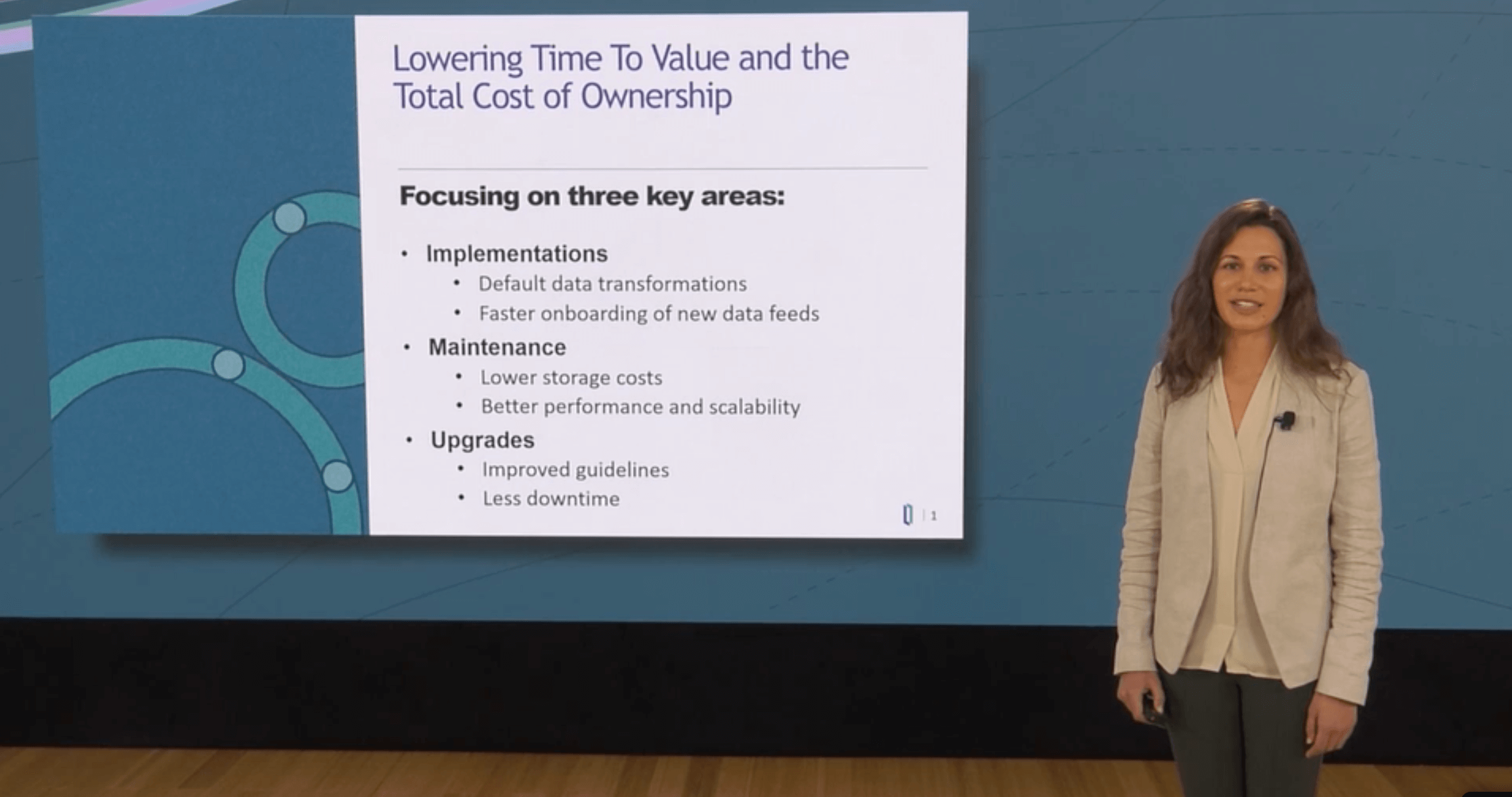
Goddard also highlighted an HL7v2 Data Profiling Tool, which analyzes messages for non-conformance to standards and allows users to quickly identify and drill into problem areas.
Overall, Teich believes that the drivers for change remain largely the same but are most assuredly accelerating. InterSystems is focused on making data actionable and designing solutions that are modular and configurable.
Keynote InterSystems IRIS: What’s New and Next

- Date: October 27, 2021
- Presenter: Jeff Fried, Product Director, InterSystems
- Overview: InterSystems’ Director of Product Management, Jeff Fried, leads a team presentation on InterSystems IRIS capabilities, new enhancements, and the speed and flexibility of IRIS, which includes major improvements, such as Embedded Python and tools for FHIR adoption.
InterSystems IRIS has been on the market for about three years, and its usefulness and efficiency are now well-proven. Jeff Fried, InterSystems’ Director of Product Management, explained that IRIS is a unified data platform for high-performance applications. IRIS supports cloud, on-premise, and hybrid deployments.
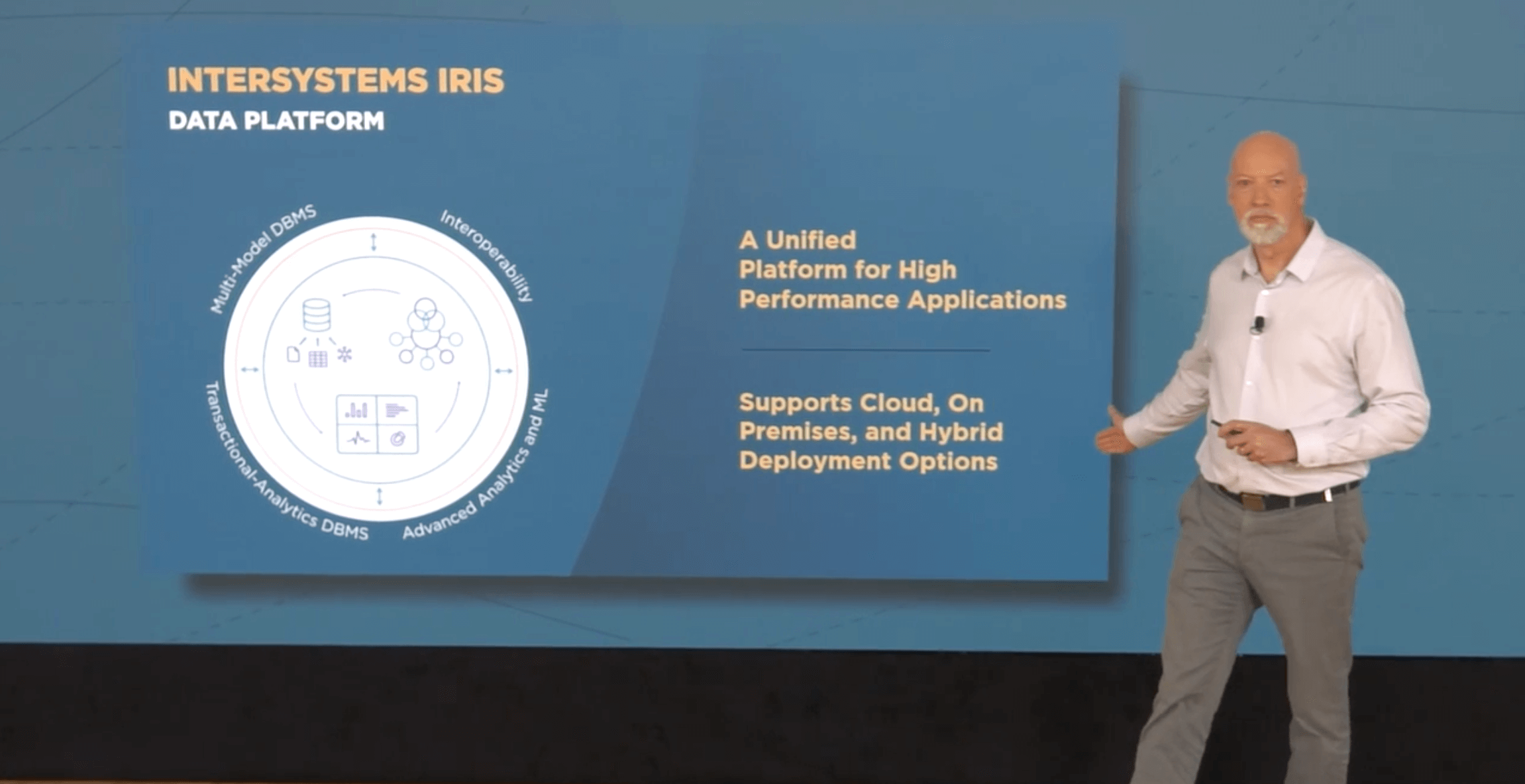
For clients using Caché and Ensemble, InterSystems has worked to make migrating to IRIS an easy and efficient process. Fried listed the following features in IRIS 2021.1:
- Analytics and AI – InterSystems IRIS Adaptive Analytics, IntegratedML (machine learning), Reports, BI & SQL enhancements
- Cloud & Operations – InterSystems Kubernetes Operator and ARM support in cloud and on-premise
- Better Development – Comprehensive client SDK and Gateway portfolio
- Better Interoperability – InterSystems API Management v3.1 and significant FHIR enhancements
Fried cited significant release-on-release performance improvements from Cache 2016.2 to InterSystems IRIS 2019.1 to InterSystems IRIS 2021.1 based on customer information. InterSystems IRIS is now three times faster than Caché.
In the next release, 2021.2, IRIS provides the following updates:
- Better Development – Embedded Python, Node js 14, and PeX for Python
- Analytics & AI – Adaptive Analytics enhancements and SQL Loader
- Cloud & Operations – New cloud services, including HMTS & FAS; Cloud connectors, including S3, SNS, Cloudwatch, and Healthlake; IKO enhancements, including quick scale-up recipes
- Scale, Speed, & Security – Online shared rebalancing, dynamic SQL optimizer, journal compression, stream compression, TLS1.3, and OAuth2 support for email
InterSystems supports developers’ ability to use the languages of their choice and features containerization and use of Kubernetes.
IRIS Adaptive Analytics allows data stewards or designers to create data models with intuitive naming conventions and put those in front of business analysts to use in their analytics work. Of note, Adaptive Analytics uses machine learning from all users to anticipate data needs and speed up responses over time. An analyst in one department who queries for certain data helps make the platform faster when an analyst in another department works with the same or similar data for other purposes. All of this is based on virtual data cubes and a centralized data model.
Adaptive Analytics supports any front-end BI tool of choice, whether that is Tableau, Qlik, MS Excel, or something else, making the technology valuable and accessible for as many organizations as possible. InterSystems has also made investments in embedded reporting and IRIS BI as a resource for organizations perhaps just starting out on their analytics journey.
Embedded Python taps into a community of over 8 million developers around the world and over 300,000 packages, accessible through IRIS. Presenters shared a short demonstration using a REACT UI and IRIS REST service to quickly visualize, organize, and profile a sample data set.
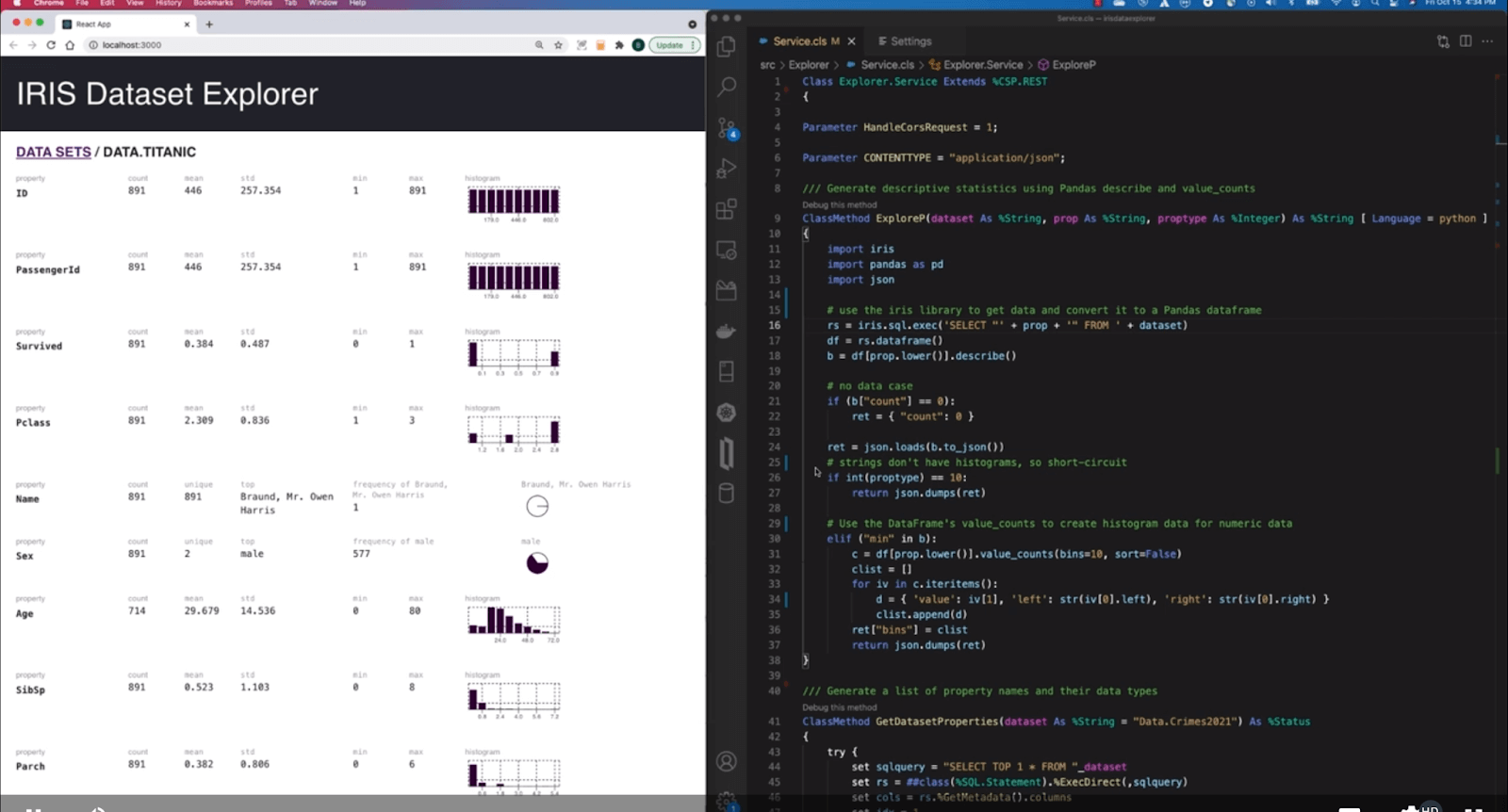
Examples of potential uses of Python include extracting information from images and generating MS Word documents through IRIS on the fly.
Fried’s team also shared information and a short demonstration of the HealthShare Message Transformation Service, which gives users an intuitive UI to convert messages using older standards into FHIR resources. The tool allows users to see a summary of FHIR resources that are extracted from messages and expand and drill down to view details about data elements.
While the tool allows individual message exploration, it can also handle bulk message transformations at the rate of hundreds of thousands of messages per minute, which InterSystems estimates to be 200 times faster than other similar tools.
The team also described a new FHIR Schema Generator to project data as SQL tables using a simple, as well as an easy-to-use UI and a FHIR SQL Builder to analyze a FHIR repository, display resource/element counts, obtain user selections, generate SQL projections, and run maintenance scripts.
InterSystems is currently working on tools to simplify deploying IRIS services through AWS. The team provided a simple demo and mentioned that they are receiving feedback on this functionality at this time. It is not yet ready for production but is in development.
Fried ended the session by promising continued investment in customer-centric solutions like these and including customers in the discussion as these technologies are developed.
| Part One | Part Two |
|---|
Thank you for joining us for this year’s InterSystems Virtual Summit recap. Be sure to check out part two!
J2 Interactive is an award-winning software development and IT consulting firm specializing in customized solutions for hospitals, labs, research institutions, and health information exchanges.
Our approach to design and development is rooted in a fundamental belief that systems succeed or fail based on how well they serve the people who depend upon them. Drop us a line to learn more.



